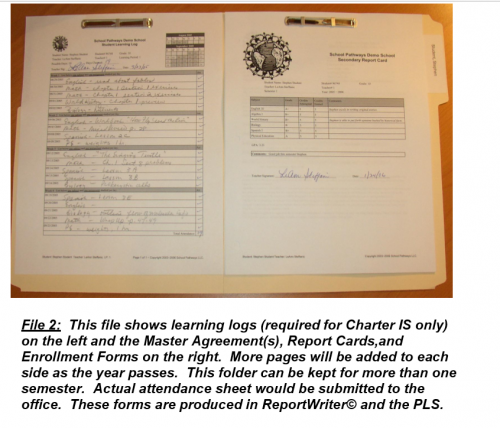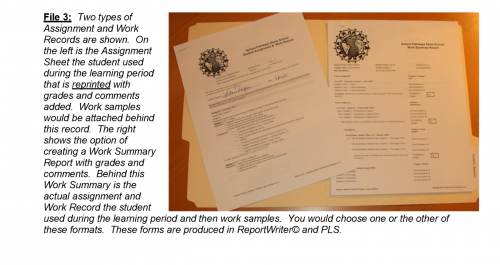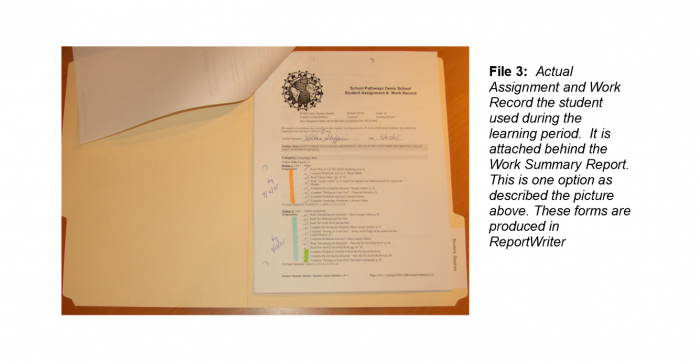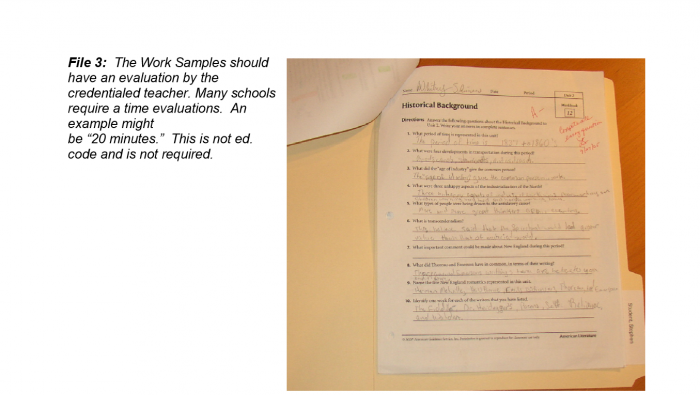Passing Your Audit
School Pathways has compiled a reference list of items to assist your school in passing the audit process. The State frequently updates its interpretation of codes governing independent study programs. And charter independent study programs. Therefore, it is an essential responsibility of administrators and teachers to stay current on California Educational Code.
This document provides critical information in regard to Independent Study Operations Manual published by the CDE. It also gives information on the Self-Assessment 2012 Compliance Guide developed by the California Consortium for Independent Study (CCIS) compliance team. Two vital areas are board policy and administrative regulations which are essential for apportionment. This document will touch on board policy but mainly focuses on Administrative regulations. Our recommendations on student record keeping are merely suggestions.
Master Agreement
Master agreements must be concise documents. Adding more information than is needed can actually lose ADA rather than retain it. If you have other items you would like your students/families to agree upon, you might consider developing a separate agreement to be kept in a non-auditable file. Acknowledgment of Responsibilities is SPs own solution to a document that can be used for such a purpose.
The School Pathways Master Agreement complies with the CCIS Compliance Manuals legal recommendations. The Master Agreement has been approved by auditors as well as attorneys as meeting all requirements. Please refer to Educational Code §51747 and §51748 for specific requirements.
Two items on the Report Writer Info page are important to the master agreement are the following:
- Program Placement field
- Classroom Option
If still using ReportWriter, you need to make sure they are completed for two reasons:
- Auditors are looking for one of three things in the Program Placement field: General Education, Special Education, or Adult education. Do not enter Independent Study in this field. If you are using School Pathways SIS, this field is automatically populated on the Master Agreement (MA).
- Since all students sign a MA that states “Independent Study is a continuously voluntary educational alternative and a classroom option is always available,” auditors want to know where that classroom option is. In the Classroom Option field enter the school district the student would be attending by the district boundaries they reside in. If you are using School Pathways SIS, this field is automatically populated on the MA.
Other information that is required on the Master Agreement is:
* Student Name * Student Birth Date * Student Address * Student Phone Number * Student ID Number * Student Enrollment Date * Grade Level
Other Basic information that is required (and inputted on the MA in ReportWriter or the web based PLS) is as follows
- Subjects and Course Values
- Objectives for courses attempted
- Methods of study for courses attempted
- Specific Resources (can be listed on Assignment and Work Record)
- Methods of Evaluation (report cards, student conferences, observations, tests, etc.)
- Manner of Reporting (one-on-one, small group, fax, email or mail)
- Time and day of reporting
- Frequency of student reporting to teacher (once a week, once a month etc.)
- Location/ Place of reporting
- Beginning and ending dates of Agreement
- Duration of Agreement (One semester, 6month, or year-long)
- Dated signatures (student, parent/guardian, teacher, and any other person who has direct responsibility. This may include other teachers, paraprofessionals, volunteers etc.)
- Number of missed assignments allowed per your board policy
- State the maximum length of time that may elapse between dates the assignment is made and date the assignment is due per board policy specifications
- Continuously Voluntary Statement
- Statement that this program is available as an option for suspended or expelled students and the student is offered the alternative of classroom instruction
Student assignment/Work Records are required for each learning period of a student’s attendance at your school. These records supplement the Master Agreement and must match this document in the area of the course plan. Teachers are required by the state to coordinate and assign a bulk of work to their students each learning period and then to assess that work when it is due [Ed. Code §51747.5. (a)(b) and CA code of Regulations §117000(f) (j)]. The amount of work assigned during this period should match the amount of work a student would be given if they were in the regular classroom. The student assignment and work record should contain the following:
- Course of study/ subjects are taking
- Learning objectives for the assignments made
- Methods of study- the assignments or the means by which a student is to achieve the objectives
- A list of resources and materials (texts, workbooks, videos, computer activities, projects)
- Evaluation for attendance and academic credit. This can also be shown on the work samples.
- Date assignments are made and date assignments are due
- Grades and/or credits earned after the assignments are completed (This information may alternately be kept in a gradebook or final report such as a report card)
- Attendance credit (May also be kept in an attendance book or final report)
- Signature or initials of certificated teacher
Work Samples
Representative work samples of student work must be on file for each student and these samples must be evaluated by a certificated teacher. As of July 2014, teacher signature and date are no longer required on student work samples. Representative work samples are defined in your board policy. Since each school’s definition is different, you might have one school that kept one sample per day hitting each subject throughout the week while having another school that keeps two samples during the semester. The “norm” is one sample per subject per month. The important thing is, once your board policy is set, you must follow the policy.
Required on Work Samples:
- Evaluation such as Grade, OK or Checkmark
- NO LONGER REQUIRED AS OF 07/2014: Certificated teacher signature OR initials. Date of Assessment is no longer required either
A notation of the assessment evaluation for attendance credit (number of days/ hours the sample represents) is suggested. It is also recommended by the CCIS Compliance Team that a value determination be made on work samples, although this is not evident in Ed. Code. See the following [CA. Code of Regulations §11703(b) (3)]. ReportWriter© and the PLS handle this by having the teacher enter the number of apportionment days possible and earned on the front of the Assignment and Work Record OR Work Summary Report.
Work Samples should also include subject of sample, student’s name, and date of assignment
Auditable Records
Auditors are looking for specific files only. Giving files to an auditor that are not required could hurt rather than help your audit outcome. All the files mentioned below must be kept for a three year period. Beyond the specific student files (discussed in the next section), the following files must be made readily available to auditors:
- Your district policy, Board Policy, Administrative Regulations, and Procedures pertaining to your program.
- A list of all students who have participated or are currently enrolled in your school/program during the current year. Include in this file credits attempted and awarded for each student and a record of the student’s attendance.
- Attendance registers for all students (or electronic files from your SIS)
- If using a method of accounting for attendance other than the state-approved register a letter of approval is required by the CDE (unless you are a Charter School).
- A list of teachers that includes their student rosters which will allow an auditor to calculate the ratio of student ADA/ teacher which can then be compared to the ratio of other instructional programs in the district.
- The written evaluation of a non-producing student (this could refer to academics or attendance credits) Evaluation of the student must state if it is in the best interest of the student to remain in Independent Study. This record must transfer with the student if the student transfers to another California public school. Criteria for this evaluation must be stated in board policy.
Student Files
Student files are often the first stop for auditors. These files will either set up your audit for success or signal the beginning of a search and destroy operation of your school. Student files should have specific items and no more. Other items you may be saving on your students should be kept in a separate file that is not auditable. Student files should only be stored for three years plus the current school year.
School Pathways recommends you have two files. One file is for student specific documents and the other for the Student Assignment/Work Records and representative learning samples. The second file can become quite large and cumbersome because of students work samples. Keep these two files together in your records. Some schools color code so files are easily retrievable.
If you are using School Pathways electronic archiving, all auditable documents are stored in the SIS archive compliance area. Check with your auditor to get approval for the electronic signatures and archiving documents in the SIS.
File 1 Student CUME file
- Transcripts
- Immunization Record
- Testing results
File 2- Specific Documents
- The Master Agreement (including any Addendums or Subsidiary Contracts
- Student enrollment form (helpful but not required)
- Records of attendance

- Student Learning Logs (if Independent Study charter school.) there are several options in this form. Talk to School Pathways and your auditor for suggestions
- Records of credits, grades and other evaluations of assignments such as progress reports or report cards.
- Evaluations of non-attendance
File 3- Student Assignment and Work Records
These are usually kept in same area as File 2 although in a separate file.
- Student Assignment/Work Record for each learning period.
- Representative work samples attached to watch Student Assignment/ Work Record. Follow your board policy in this matter
- On the ReportWriter and PLS Assignment/Work Record, ADA is noted by the teacher [Educational Code §51747.5(b)]. There are two ways to grant attendance depending on the type of school you are. Please pay close attention to which applies to your school.
Further Descriptions of Files
File 2
This file shows Learning Logs (required for Charter IS only) on the left and the Master Agreement(s), Report Cards, and Enrollment forms on the right. More pages will be added to each side as the year passes. This folder can be kept for more than one semester. Actual attendance sheet would be submitted to the office. These forms are produced in ReportWriter and the PLS.
- If you are a CHARTER Independent Study Program, the student must complete a contemporaneous record (learning log) that notes at least one assignment completed each school day. If an assignment was noted for each day, the teacher may claim a day of attendance for each day of the learning period. This learning log is available in ReportWriter© and PLS.
- If you are a District Independent Study program and school, you must calculate the number of attendance days earned during the learning period based on the time value of student work products, as judged by the certificated teacher.
File 3

This is the actual assignment and Work Record the student used during the learning period need to be attached behind the Work Summary report. This is one option as shown in the picture above. These forms are produced in ReportWriter© or PLS.
The Work Samples should have an evaluation by the credentialed teacher. Many schools require a time evaluation, for example “20 minutes”. This is not Ed. Code requirement.


Please contact School Pathways Team for further clarification on compliance issues. If we don’t know the answer, we will steer you in the right direction!
The foregoing reference list and synopsis of the “Self-Assessment 2009 Compliance Guide” is intended to assist you in satisfying state requirements and passing an audit. However, compliance with the reference list is not a guarantee of success. School Pathways makes no representation that any particular course of action will assure compliance with a state audit. School Pathways recommends that you refer to the completer compliance guide for further assistance and seek professional audit and legal aid.